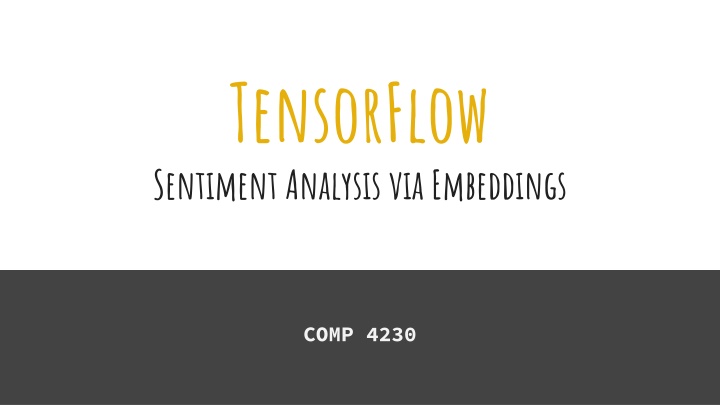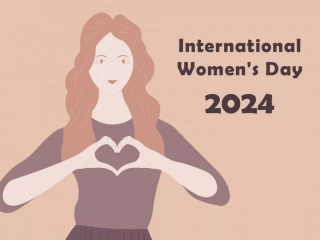
Understanding Sentiment Analysis and Its Applications
"Explore the world of sentiment analysis via embeddings and discover the nuances of deduction, induction, and abduction. Join the class discussion on affective states and subjective information to delve deeper into natural language processing and computational linguistics. Dive into the realm of sentiment analysis through real-world examples and discussions led by experts like Dan Jurafsky."
Download Presentation

Please find below an Image/Link to download the presentation.
The content on the website is provided AS IS for your information and personal use only. It may not be sold, licensed, or shared on other websites without obtaining consent from the author. If you encounter any issues during the download, it is possible that the publisher has removed the file from their server.
You are allowed to download the files provided on this website for personal or commercial use, subject to the condition that they are used lawfully. All files are the property of their respective owners.
The content on the website is provided AS IS for your information and personal use only. It may not be sold, licensed, or shared on other websites without obtaining consent from the author.
E N D
Presentation Transcript
TensorFlow Sentiment Analysis via Embeddings COMP 4230
ALERTS Read Moroney Chapter 6 Read Larson Chapter 11
Discussion What is deduction? What is induction? What is abduction? Class discussion on Friday Make sure to bring your book and be caught up on readings
What is Sentiment Analysis? Also known as opinion extraction, opinion mining, or subjectivity analysis "The use of natural language processing, text analysis, computational linguistics, and biometrics to systematically identify, extract, quantify, and study affective states and subjective information." Wikipedia It has the goal of understanding whether the sentiment behind a piece of text is positive, negative, or neutral.
Dan Jurafsky Positive or negative movie review? unbelievably disappointing Full of zany characters and richly applied satire, and some great plot twists this is the greatest screwball comedy ever filmed It was pathetic. The worst part about it was the boxing scenes.
Dan Jurafsky Google Product Search a
Twitter sentiment versus Gallup Poll of Consumer Confidence Brendan O'Connor, Ramnath Balasubramanyan, Bryan R. Routledge, and Noah A. Smith. 2010. From Tweets to Polls: Linking Text Sentiment to Public Opinion Time Series. In ICWSM-2010 Dan Jurafsky
Dan Jurafsky Why sentiment analysis? Movie: is this review positive or negative? Products: what do people think about the new iPhone? Public sentiment: how is consumer confidence? Is despair increasing? Politics: what do people think about this candidate or issue? Prediction: predict election outcomes or market trends from sentiment
Dan Jurafsky Scherer Typology of Affective States Emotion: brief organically synchronized evaluation of a major event angry, sad, joyful, fearful, ashamed, proud, elated Mood: diffuse non-caused low-intensity long-duration change in subjective feeling cheerful, gloomy, irritable, listless, depressed, buoyant Interpersonal stances: affective stance toward another person in a specific interaction friendly, flirtatious, distant, cold, warm, supportive, contemptuous Attitudes: enduring, affectively colored beliefs, dispositions towards objects or persons liking, loving, hating, valuing, desiring Personality traits: stable personality dispositions and typical behavior tendencies nervous, anxious, reckless, morose, hostile, jealous
Dan Jurafsky Scherer Typology of Affective States Emotion: brief organically synchronized evaluation of a major event angry, sad, joyful, fearful, ashamed, proud, elated Mood: diffuse non-caused low-intensity long-duration change in subjective feeling cheerful, gloomy, irritable, listless, depressed, buoyant Interpersonal stances: affective stance toward another person in a specific interaction friendly, flirtatious, distant, cold, warm, supportive, contemptuous Attitudes: enduring, affectively colored beliefs, dispositions towards objects or persons liking, loving, hating, valuing, desiring Personality traits: stable personality dispositions and typical behavior tendencies nervous, anxious, reckless, morose, hostile, jealous
Dan Jurafsky Sentiment Analysis Sentiment analysis is the detection of attitudes enduring, affectively colored beliefs, dispositions towards objects or persons 1. Holder (source) of attitude 2. Target (aspect) of attitude 3. Type of attitude From a set of types Like, love, hate, value, desire, etc. Or (more commonly) simple weighted polarity: positive, negative, neutral, together with strength 4. Text containing the attitude Sentence or entire document
Simplistic Example If a sentence is negative, we can assume that each word contributes equally to this sentiment; likewise if the sentence is positive Associate with each word in the training data the sum of positive and negative sentences it participates in. This is a relative measure of a word's positivity/negativity Given a test sentence, add up the values of all the words to predict whether the sentence is positive or negative What seem to be the weaknesses with this idea?
Vectors The simplistic example used a one dimensional measure More nuanced discrimination can be done with multi-dimensional vectors What is wrong with this graph? Pride and Prejudice, Jane Austin
Embeddings A multi-dimensional vector that represents a word which is learned while training a backprop neural net Implemented in TensorFlow as a keras layer tf.keras.layers.Embedding(vocab_size, embedding_dim) A complete model might look like this: model = tf.keras.Sequential([ tf.keras.layers.Embedding(10000, 16), tf.keras.layers.GlobalAveragePooling1D(), tf.keras.layers.Dense(24, activation='relu'), tf.keras.layers.Dense(1, activation='sigmoid') ])
Next Time... Lab 4






















